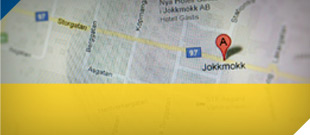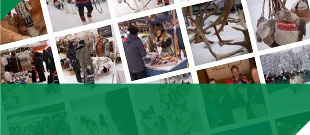A Winter Market at the Beginning of the 17th Century
What would a market held at the beginning of the 17th century look like? How many people would come? How were people clothed? What did they eat? What language was spoken? Though there is a lot we do not know, some things can be discovered in contemporary reports, others we can guess or imagine.
In a report written in April 1606 by Daniel Hjort, the king's envoy, he tells of the situation in Jokkmokk. From the 11-13th of February he had held court in Jokkmokk for the Sámi and the tax collectors from the Lule Lappish territories. They had created regulations for the market and the church town. It is easy to see there were a lot of impediments. The priest, Rev. Lars, who had been assigned to Jokkmokk was quite sickly, didn't know the Sámi language and was "not very well learned". The parish desired that another priest be assigned who could handle the conditions in the Lappish territories. Rev. Laurentius Olai, the chaplain in Luleå, was considered a better fit and was chosen as replacement.
Those present promised to deliver logs to build the church by Easter, and the building would be finished during the summer. Appropriate dates for market and for the court sessions had also been discussed. The Sámi were willing to be in the area from Thomasmass and stay until Candlemas, in other words, from Christmastime until early February. The bailiff was ordered to be here by Epiphany to collect taxes for the crown. After the mass of January 25th it was free for the former tax collectors, the birlkarlar, to trade with the Sámi. For that privilege they were to pay one tenth as a tariff to the crown.
After Candlemas the Sámi were free to leave the church town in Jokkmokk. On the 25th of March, the day of Mary’s Annunciation, they were to return for two weeks. They would once again meet the priest and the traders. First the bailiff would buy the furs from wild game for the needs of the crown. After that the traders were welcome to deal with the Sámi. And the priest was ordered to be as busy as he could in his call and office.
To hold court sessions during the market was an important duty of the bailiff. Already during the first documented court session in Jokkmokk in 1606, the jury consisted of both Sámi and traders. After some time the jury consisted only of Sámi. The court sessions dealt mainly with issues that affected the local population—questions about fishing rights, grazing areas for the reindeer and economic disputes. During the 17th century mountain reindeer herding was developed in the Lule Lappish territories and the mountain Sámi villages were given the elongated shape they still have today. The right to grazing lands and border disputes became more common in the cases heard in court.












